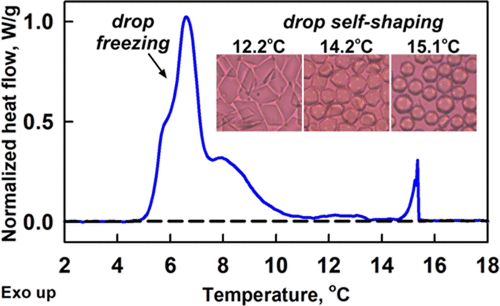Multilayer formation in self-shaping emulsion droplets

In several recent studies, we showed that micrometer-sized oil-in-water emulsion droplets from alkanes, alkenes, alcohols, triglycerides, or mixtures of these components can spontaneously “self-shape” upon cooling into various regular shapes, such as regular polyhedrons, platelets, rods, and fibers (Denkov, N.,et al. Nature 2015, 528, 392; Cholakova, D.,et al. Adv. Colloid Interface Sci. 2016, 235, 90). These drop-shape transformations were explained by assuming that intermediate plastic rotator phase, composed of ordered multilayers of oily molecules, is formed beneath the drop surface around the oil-freezing temperature. An alternative explanation was proposed (Guttman, S.,et al. Proc. Natl. Acad. Sci. USA 2016 113, 493; Guttman, S.,et al. Langmuir 2017, 33, 1305), which is based on the assumption that the oil−water interfacial tension decreases to very low values upon emulsion cooling. Here, we present new results, obtained by differential scanning calorimetry (DSC), which quantify the enthalpy effects accompanying the drop-shape transformations. Using optical microscopy, we related the peaks in the DSC thermograms to the specific changes in the drop shape. Furthermore, from the enthalpies measured by DSC, we determined the fraction of the intermediate phase involved in the processes of drop deformation. The obtained results support the explanation that the drop-shape transformations are intimately related to the formation of ordered multilayers of alkane molecules with thickness varying between several and dozens of layers of alkane molecules, depending on the specific system. The new results provide the basis for a rational approach to the mechanistic explanation and to the fine control of this fascinating and industrially relevant phenomenon.

